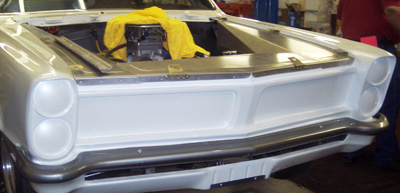

Let there be lights!












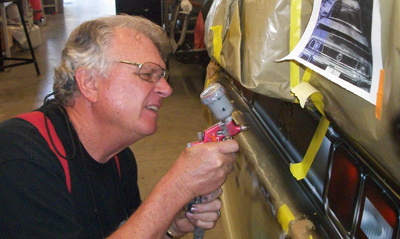 A few columns ago, we all were discussing the many faces of Don Prudhomme’s first Hot Wheels Funny Car, marveling at the number of changes it underwent in its debut season, especially in the grille and headlight area.
A few columns ago, we all were discussing the many faces of Don Prudhomme’s first Hot Wheels Funny Car, marveling at the number of changes it underwent in its debut season, especially in the grille and headlight area.
The whole discussion got me to thinking about the artistry involved in creating those faux front fascias, the skill to bring depth and dimension to a flat surface and to make headlights look like headlights, and not just circular orbs of paint.
It wasn’t a hard choice on whose brain to pick as Kenny Youngblood has been applying his artistic talents to Funny Cars for decades. I asked him to shine a light on the topic with a brief primer on Headlights and Grilles 101.
Take it away, Kenny.
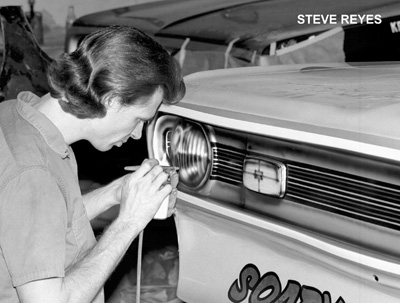 The first “painted” headlights I remember seeing on a Funny Car were on Tom “the Mongoose” McEwen’s original Hot Wheels Duster, at Lions Drag Strip in 1970. They had been airbrushed by the incomparable Tom Kelly, and, even though they were done very simply (painted as if they were ‘on’ with a cross hatch of white over the silver-based grille), I was blown away.
The first “painted” headlights I remember seeing on a Funny Car were on Tom “the Mongoose” McEwen’s original Hot Wheels Duster, at Lions Drag Strip in 1970. They had been airbrushed by the incomparable Tom Kelly, and, even though they were done very simply (painted as if they were ‘on’ with a cross hatch of white over the silver-based grille), I was blown away.
I had been working at Dick Olsen and Don Kirby’s paint shop in Bellflower, Calif., for just over a year and no one (including me) had ever painted any faux grille, headlight or taillight details on a Funny Car; they were just left blank. Every car we painted thereafter, however, would get the airbrush treatment.
I cringe now when looking at the Steve Reyes photos of the headlights we did back in the day (on cars like Rich Guasco’s Pure Hell Duster); they were really crude! The shading was upside down and they were done in black and white only. But, back then, they were nevertheless the hot ticket. Kirby’s paint jobs combined with my airbrush work put us in great demand and we were soon painting, lettering, and doing the “lights” on most of the top Funny Cars of the era.
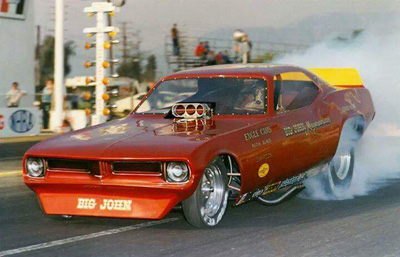 Of the most beautiful cars back then, none were prettier than the gorgeous candy red ‘Cudas of “Big John” Mazmanian. Tom Kelly also lettered John’s cars and rightfully so; his gold leaf work and script lettering were exquisite. I did, however, end up doing a couple of cars for “Maz” because he liked my grilles and headlights! Ironically. and years later, Kelly and I would collaborate on two nostalgia Funny Cars: John Troxel’s Dodge Challenger and the Worsham’s Blue Max Mustang II, with Tom doing the lettering and me the grilles and taillights.
Of the most beautiful cars back then, none were prettier than the gorgeous candy red ‘Cudas of “Big John” Mazmanian. Tom Kelly also lettered John’s cars and rightfully so; his gold leaf work and script lettering were exquisite. I did, however, end up doing a couple of cars for “Maz” because he liked my grilles and headlights! Ironically. and years later, Kelly and I would collaborate on two nostalgia Funny Cars: John Troxel’s Dodge Challenger and the Worsham’s Blue Max Mustang II, with Tom doing the lettering and me the grilles and taillights.
I was way more of an artist than a sign painter; guys like Kelly, Steve Feinberg, Walt Prey, Dennis Rickleffs, Dennis Jones, Nat Quick, and Jack Burr could hand-letter circles around me. My customers had to go by the “10-foot rule” -- from 10 feet away my lettering looked pretty good!
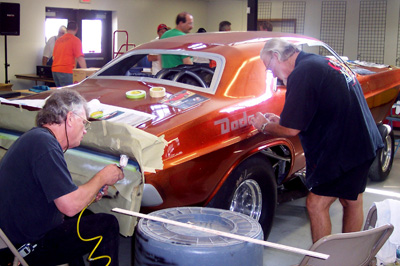 But when it came to the more artistic things (like designing the ‘big name’ on the side of the car and airbrushing the grilles and lights) I was ahead of the pack, and for me it was the most fun part of the job. Fun like when I was doing the Lil’ John Buttera-built Maverick for Mickey Thompson, and driver Arnie Behling asked me if I could put the reflection of a cone in one of the headlights (maybe the first but certainly not the last time this would be done).
But when it came to the more artistic things (like designing the ‘big name’ on the side of the car and airbrushing the grilles and lights) I was ahead of the pack, and for me it was the most fun part of the job. Fun like when I was doing the Lil’ John Buttera-built Maverick for Mickey Thompson, and driver Arnie Behling asked me if I could put the reflection of a cone in one of the headlights (maybe the first but certainly not the last time this would be done).
As far as airbrushing the grilles was concerned, I not only had the art ability I’d inherited from my family (my dad, mom and uncle were all painters), but the training I’d received from the best art teacher I could ever have had: my mother, Marie Youngblood.
She had an incredible knowledge of art and had taught me the “rules” -- the rules of perspective, shading, color, and so on. Because the rules of art apply in every case (whether you’re painting the Mona Lisa or airbrushing the trim on a ‘70 Barracuda), I was able to give the grilles the three-dimensional look they required. I wanted them to look so real that someone would “break their fingernails trying to open the hood!”
The first ‘colorized’ headlight and grille treatments I remember seeing were done by the talented team of Jim Moser and John “Waldo” Glaspy, on I think one of Ed “the Ace” McCulloch’s cars. The bar had been raised, and we all had to step up! Adding color to the faux headlights, taillights, and grilles gave them the realism we see today.
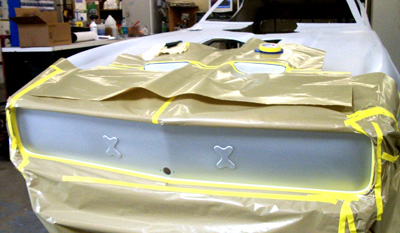 Before and after headlights and grille on Dennis Taylor Mustang nostalgia Funny Car. |
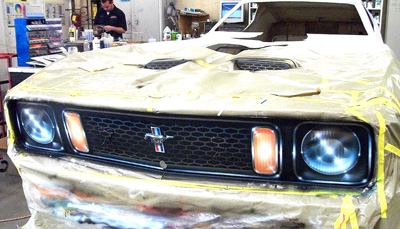 |
|
|
 |
Normally the process goes like this (at least the way I do it): working on a silver base, everything you want to “be chrome” (like headlight rings, bezels and grille bars) is masked off. Then you come in with black in the airbrush and add the shadows and dark reflections to the (“off”) headlights, as well as blacking out the area “behind” the grille bars. Before taking the black out of the gun, you unmask the “chrome” trim, and add some shading as needed.
Next a transparent (or thinned down) earth tone is blended over the black shading in the top half of the concave headlight buckets, and onto any other surface that would reflect “the ground.” Then, a transparent mixture of sky blue is blended over the bottom half of the headlight and onto any other surface that would reflect “the sky.”
The final step is to put opaque white in the air pencil and add the highlights and spectral reflections (reflections of “the sun”). This is when it really comes to life! The white highlights make it pop and give it the look of real chrome. A simple tool I’ve used for years when highlighting the headlights is a common hair pick. Blowing white through the pick gives the lights an authentic look and it’s easy to do. The finished job is then clear-coated to protect the delicate airbrush work and bring out the colors.
Hand painted headlights on Funny Cars (like a million other things) would be replaced with digitally-created vinyl counterparts, and the “art form” would become a thing of the past. That is until the advent and popularity of nostalgia drag racing, where most Nostalgia Funny Car owners wanted to replicate the hand-lettered and airbrushed paint jobs of the ‘70s; we were back in business!
Airbrush artistry has evolved over the years; the work of guys like Glenn Weisgerber and Eric “Stick Man” Reyes is light years ahead of what we did back in the day. With that said, I’ll leave you with one more (and my favorite) “headlight story” from back in those days.
It was 1971; I was finishing up the lettering on the Bergler & Prock Vega, with driver (and crew chief Jimmy Prock’s dad) Tom Prock looking on. As I was taping out the grille and headlights, the ever-stoic Prock says, “Kenny, I just have one question; are you going to paint the headlights on or off?” My immediate response was, “Are you going to be racing in the daytime or the nighttime?”
Thanks for the (ahem) illuminating information, Kenny. Kenny also pointed me to some YouTube links where you can watch him in airbrush action as he paints the grille of Taylor’s flopper.
https://youtu.be/XaGy3Nr51bc
https://youtu.be/qZp1wio5vCs
https://youtu.be/wFYxNHxy_YM
I hope you enjoyed this behind the scenes look at one of the perhaps least understood but well-appreciated facets of what makes ‘70s Funny Cars so cool. I’ll see you next week.




















































